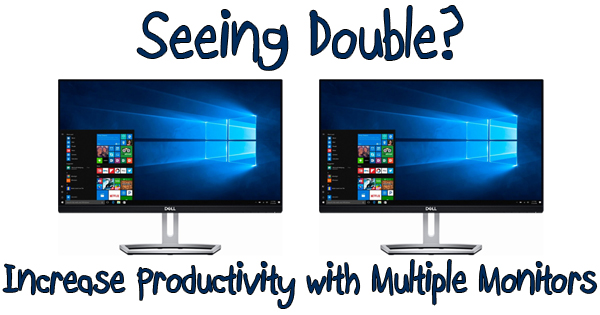
These days, we’re all expected to multitask. Businesses the world over are looking to make their employees more productive to maximize work output in the least amount of time. Since everything is done via the computer, it makes sense to look toward technology in this quest. One of the easiest ways to make your work life more efficient is by using multiple monitors. Imagine the possibilities of having two (or more) screens sitting in front of you! Today, we’ll show you how to make that a reality.
If you’re considering taking the leap to multiple monitors, you need to first take a look at your computer. There are typically three types of display ports found on a P.C.: VGA, DVI, or HDMI. VGA is the oldest technology of the three. A VGA connector is sort of D shaped, has fifteen pins, and is typically (but not always) colored blue. A DVI connector is much longer, containing twenty nine pins. It’s usually white in color. Finally, HDMI is the newest technology and the easiest to spot. It’s black, is recessed into the back of the computer, and is normally labeled HDMI. If you’re using a desktop computer, you’ll need to find two of any combination of these ports. This is because you’ll need one port per monitor. If you’re using a laptop and want to add another monitor, you’ll only need to find one display port. If you’re not finding enough ports, you’re not dead in the water. The best option is to add an expansion video card to your computer. Something like this is all you need to be on your way to multiple monitors.
After identifying the available ports on the computer, it’s time for the fun part – buying the monitors. Well, I guess depending on how expensive the monitors are will dictate just how much fun you’re having! Most monitors in 2018 will come with DVI and/or HDMI connectors. If you need to take an HDMI monitor to a VGA port on the computer, you’re going to need an adapter. I successfully used this monitor on a job recently: VicTsing VGA to HDMI Converter Adapter. There are also HDMI to DVI adapters, as well as DVI to VGAs, so nothing is impossible. With the monitors and correct ports and cables in place, shut down the computer and hook everything up.
Turn the computer on, and a whole new world awaits you. In Windows 7, right-click an open area on the desktop, and click “Screen Resolution”. You’ll notice that at the top of the window there will be two (or however many monitors you have connected) monitors showing. Click on the “1” and you’ll be able to set that monitor as your primary. Click on the “2” and look for the “Multiple Displays” dropdown. You have four options: “Duplicate These Displays” which means the same image will be shown on both monitors; “Extend These Displays” makes the second screen act like the right side of the first screen. It’s a blank screen that can show anything you’d like; “Show Desktop Only on 1” shows everything on the first monitor and nothing on the second; and “Show Desktop Only on 2” shows everything on the second monitor and nothing on the first. Most people choose “Extend These Displays” to take advantage of the extra real estate that a second monitor affords them. Click “OK” when you’ve made your selection. By the way to open a program on the extended screen, go to the top right of the screen by the “red x”. Click on the middle box (between minimize and close) and make sure the window isn’t full screen. At that point, click and hold on the program’s top bar, and drag it toward the second monitor. The program will open on that screen. Cool, huh? In Windows 8, set up multiple monitors by hovering the mouse over the right side of the screen until the charms appear. Click on “Devices”, then “Second screen”. Choose from “PC Screen only”, “Duplicate”, “Extend”, or “Second screen only”, and you’re finished. In Windows 10, access multiple monitor settings by right-clicking in an open area of the desktop, then click “Display Settings”. Customize your experience as we discussed earlier in this paragraph.
If you have the room on your desk and the means to do it, using multiple monitors is really the way to go. In my situation, website design is made much easier by having a graphic program on one screen and the design program on the other. The possibilities are truly endless when you extend your desktop.
